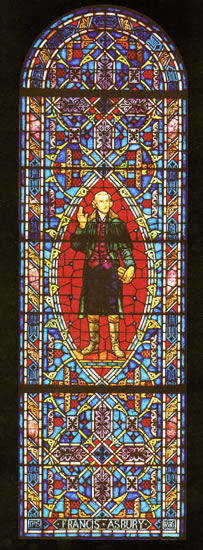
According to his Journal, Asbury placed his awakening experience between his thirteenth and fourteenth years. The experience resulted in feelings of happiness and of freedom from guilt and fear. He discovered, at an early age, considerable power over sin and felt great inward joy. He soon became adept at reading the scriptures, offering prayers, exhorting, and interpreting the Bible.
He began his traveling ministry at 21 years of age and, shortly thereafter, volunteered to go to America to preach the Gospel. For almost 45 years, traveling from Maine to Georgia, Kentucky, and Ohio, Asbury delivered his message.
The era of his ministry in the colonies included the period of the Revolutionary War. The war placed Asbury in a peculiar position: he was an English subject and hesitated to fight against the British; at the same time, he loved the people of America and felt called upon to continue his preaching ministry among them. In spite of the difficulties, he continued to preach the gospel of Christ effectively during the troublous times.
It was by an act of the famous Christmas Conference in 1784 that Asbury was consecrated a bishop. Asbury was known for a number of things: his itinerant travels, his reading habits which included almost everything written in his day, and his close adherence to the rules of the society of the Methodist Church. The development of a number of annual conferences and the setting up of a general conference occurred during Asbury’s lifetime, results of his labors.
On Sunday, March 31, 1816, the great apostle of American Methodism was called to his heavenly reward. His remains are buried in Mount Olivet Cemetery in Baltimore, Md., along with many of Methodism’s glorious dead.
The left side border symbols of the Asbury window, numbered from top to bottom, are: 1. a cross fleurie with three petals on each arm suggesting a flower and representing the sacrificial love of God manifested in the cross of Christ; 2. The Good Shepherd, based on John 10:11, illustrating Christ’s care for his flock; and 3. the Shield of St. James the Less with a saw because Hegesippus said St. James was thrown from the temple pinnacle and his body sawed in pieces.
The right side border symbols of the Asbury window, numbered from top to bottom, are: 1. a lily signifying purity, innocence, and heavenly bliss and representing the virginity of Mary, the mother of Jesus. Also it symbolizes the triumph of life over death in the Resurrection; 2. the Star of David symbolizing the shape of David’s shield, according to tradition; and 3. a staff with a purse, a traditional symbol of the pilgrim, appropriate for Asbury who has been called the “Prophet of the Long Road” (cf. John Wesley Window, border left 2).














